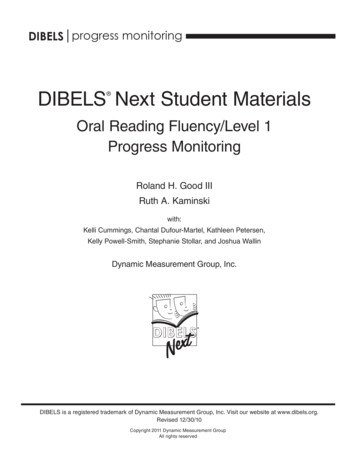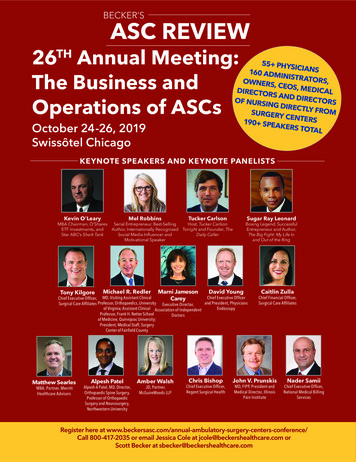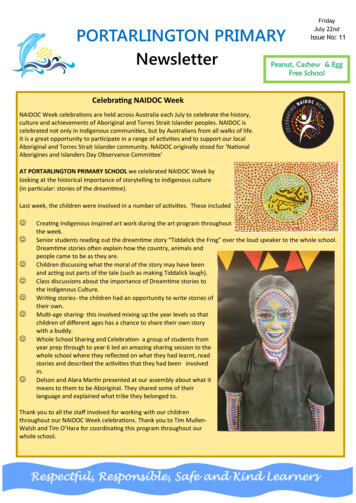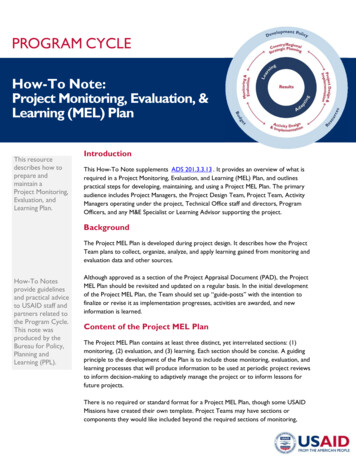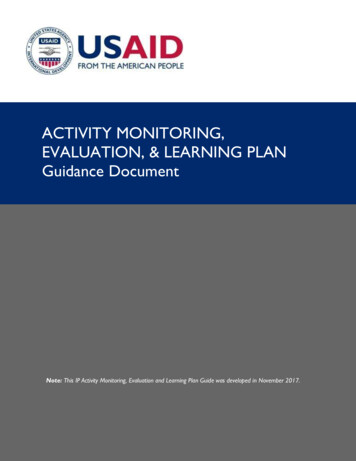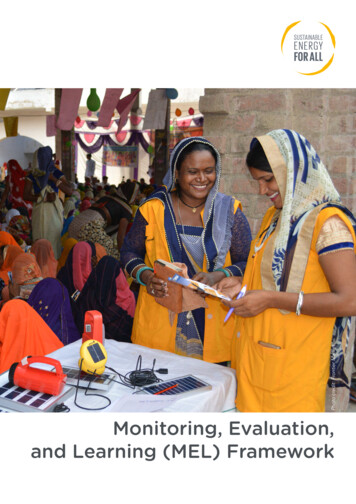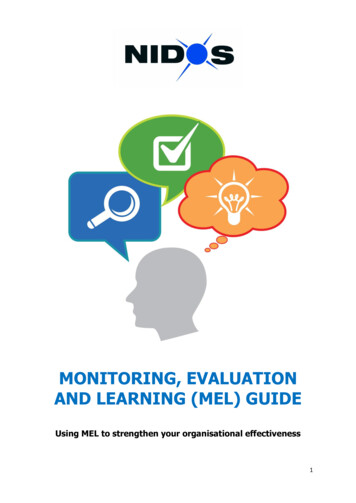
Transcription
MONITORING, EVALUATIONAND LEARNING (MEL) GUIDEUsing MEL to strengthen your organisational effectiveness1
ContentsIntroduction . 3What is MEL . 4Organisational MEL . 5Project MEL . 5The Monitoring, Evaluation and Learning cycle . 7Planning for MEL . 8Key Elements of MEL . 9MEL Planning Tools .10Data .13Types of data .13Sources of data .13Methods for data collection .14Ensuring quality of data .14MEL In Practice .16Who should be involved in your MEL work? .16Who will manage or oversee MEL? .16How much will your MEL cost? .16How much time might it take? .17Working well with consultants .17Learning .17How can you develop your organisations skills further? .18Resources .19TEMPLATE – PLANNING MEL .212
IntroductionThis MEL guide has been developed to support your international development organisationto increase knowledge, confidence and success in Monitoring, Evaluation and Learning(MEL). It aims to strengthen your organisational MEL practices; enhance your capacity tobecome more effective; and maximise your impact; through review and learning withpartners and the communities you work with. Additionally, it will equip your organisation tomeet funders’ requirements on MEL.In this guide, you will find answers to questions like: Why is MEL important? What are the benefits of MEL to project stakeholders? What is the difference between organisational MEL and project MEL and why arethey both important? What is the MEL cycle? What are the steps for developing a MEL plan? Who should be involved in MEL planning and implementation? How do you collect data? What do you do with the data collected?This guide will be useful to your organisation in two main ways. If your organisation is new to MEL - it will walk you through the steps for setting upand implementing MEL systems for your projects. If you already have a MEL system in place, it will guide you to review and improvethe MEL systems you already have in place.In either case, this guide will support your organisation’s efforts to monitor, evaluate andlearn from your project activities and results to enhance your effectiveness and impact.You do not need to read this guide from cover to cover. The table of contents willguide you to sections that may address your specific needs. It is however recommendedthat you read section 2 if your organisation is new to MEL.3
What is MELLet’s begin by defining the basic terms in this concept.Table 1: MEL explainedWhat is it?Monitoring Monitoring refers to the routine monitoring of project resources, activities andresults, and analysis of the information to guide project implementation.Evaluation Evaluation refers to the periodic (mid-term, final) assessment and analysis ofan on-going or completed projectLearningLearning is the process through which information generated from M&E isreflected upon and intentionally used to continuously improve a project’sability to achieve results.Monitoring and evaluation can help you to work out what difference you make through yourprojects. Your organisation and partners can then go on and learn from this to improve yourperformance in future.MEL activity may already be taking place in your organisation; this guide will help you totake stock of what you are already doing, put plans and systems in place and learn from it.MEL can sometimes be thought of as activity we do to allow us to report to our funder,while this is true, a good MEL system can be so much more.Table 2: Who is MEL for?Stakeholder Benefits of MELYourMEL helps your organisation answer questions like:organisation- Are you on track to achieve your mission?- Is what you are doing contributing to the long term change yourorganisation is trying to create?- Are your project activities are on track?- Are your partners’ activities are on track?- Is your intervention reaching target communities?- Are target communities experiencing anticipated changes as a result ofyour project?- Are there any challenges to address;- What is working well, what is not and why, and what could be donedifferently?Your partnersCommunitiesyou workwithMEL helps your partners answer questions like:- Are their activities on track?- Are their activities reaching target communities?- Are communities experiencing anticipated changes as a result of theproject?- Are there any challenges to address?- What is working well, what is not and why, and what could be donedifferently?MEL enables communities to:- provide critical information on their needs, abilities and capacities- input into the project design- reflect on their participation in project activities- scrutinize how the project or the organisation is operating- provide information on how the project is affecting them and changing4
their lives- participate in reflecting on project achievements- provide recommendations for how to improve project achievements.Your funders MEL allows funders to understand:- how the funds committed are used- whether funds are spent on identified needs- whether strategies to address needs are appropriate- who benefited from project activities and outputs- whether lives are changed as a result of the project- whether the changes will last after the project endsEnsuring that the needs of and benefits for each stakeholder in MEL is carefullyconsidered makes your organisation accountableThere are two levels of MEL, organisational MEL and project MEL.Organisational MELAt the organisational level, your MEL will focus on monitoring the performance of yourorganisation as a whole. The areas considered in organisational MEL include: Your organisation’s mission; Your organisational structure; Your planning, implementation and MEL processes; The relevance of your projects to your mission; and Your organisational capacity.Organisation X’s mission is to create and promote opportunities for girls to becomeempowered (personally, socially and economically) in order to be able to contribute to thedevelopment of their communities.Organisational MEL should include: how your projects meet the needs of communities you work with, and howthis relates to your mission whether your organisational structure and roles allow you to implement girls’empowerment activities what systems are in place for project planning implementation and MEL, andhow effective they are your organisation’s capacity (staff capacity, funding, partnerships, networks)to achieve your mission.Project MEL1Project MEL focuses on the following for the specific project: monitoring targets results changes challenges1Due to the target audience of this guide we will refer to projects as a unit of intervention. Largerorganisations may look at MEL from a programme perspective and terminology may differ betweenorganisations.5
This guide focuses mainly on Project MEL, but the tools can equally be applied to theorganisational level. There are however, many other tools that can be used fororganisational level MEL. Resources and guidance on organisational MEL can be found in theresourcessection.MEL for advocacyMEL can provide critical information for your advocacy work on behalf of targetcommunities. This includes information on the needs of target communities as well asthe changes they experience as a result of specific projects. Normally this has theobjective of developing new partnerships or obtaining more funding.MEL of Advocacy efforts is a specialised topic which is not covered in this guide. Youwill find links to more information on this topic in the resources section.6
MEL: the basicsThe Monitoring, Evaluation and Learning cycleMEL is an integral part of project design, implementation and completion; MEL is done at allstages within the project cycle The MEL cycle helps you to position MEL in the life of yourproject, as shown on the diagram below.Figure 1: The MEL cycle* There is no one generic project cycle and associated MEL activities. This figure is oneway of showing this.The MEL cycle starts with the initial needs assessment, this is when you identify aparticular need or problem in a specific community which your organisation is able toaddress. Ideas are generated by learning from existing projects, projects which have endedor simply through conversations with partners, communities and funders. Then you developan in depth understanding of the need or problem, its underlying causes, and how it affectsthe target communities. This is also the stage to think through potential solutions with yourpartners and target communities. Having identified a need you then need to design aproject. The project will be the most credible intervention to address the problem. A criticalstage in the MEL cycle is MEL planning. This is where you, in collaboration with yourpartners and target communities, decide the main MEL activities. You then go on to put inplace a realistic plan for undertaking them. MEL planning is a critical stage in the MELcycle where you should consider planning for the following MEL activities: conducting abaseline, undertaking routine monitoring, undertaking mid-term and final evaluations;deciding how to go about reflecting on information and learning from it to improve projectperformance.7
What is a baseline?A baseline study will establish how a target group/area is prior to the implementationof the project. It is so important to work from a good baseline as this is what you willcompare to your project results to show the change your project has made.‘bad’ baselines affect the quality and validity of project MELDuring project implementation monitoring will be an ongoing process. You should allowtime for MEL activities in staff workplans and timetable regular checks with partners toensure monitoring is taking place. It is also recommended that you conduct a mid-termevaluation. This allows you to take stock of where your project is and whether you are ontarget to achieve project outcomes. At the completion of your project a final evaluationshould be conducted. This is the stage of the MEL cycle when you evaluate, in collaborationwith your partners and communities, whether your project brought about any real change inthe lives of the communities you work with. Once the final evaluation is complete you shouldtake time to review it and take note of any learning that can be gained. This stage alsoprovides opportunity to use this learning as input to new project ideas.Planning for MELMEL planning is the process for identifying which methods to adopt for monitoring,evaluation and learning on activities, outputs and outcomes. It is also the process fordescribing: what data is needed; where the data will be collected from; how the data will be collected and analysed; when the data will be collected (baseline, routine MEL, mid-term evaluation, finalevaluation); as well as who has responsibility for collecting the data.Additionally, it specifies: how the information generated will be used; the resources that will be needed to carry out MEL activities; and how the project will be accountable to stakeholders in the process.A MEL plan, resulting from the MEL planning process, is simply the working documentproduced that guides you on how and when to implement MEL activities.Before starting the MEL planning process, providing answers to the following questionswill enable you keep the planning exercise focused: Who should be involved? Who should oversee? How much time will it take? How much will it cost?Guidance on answering these questions is given in the section MEL in PracticeSome further questions you might want to consider at this stage are:o What is the current status of project MEL? What has been done so far and by whom?o Are there staff with specific MEL responsibilities who should be involved in the MELplanning process?o To what extent are project participants, stakeholders and partners involved in MEL?8
oooWhat are partners already doing and how does this relate to the project MEL?How do project staff perceive MEL?What are some of the issues/constraints involved in project MEL?Good PracticeConsider how to actively involve partnersin the MEL planning process. Are yourpartners local? Are they international?How can you involve them in the process?Key Elements of MELAims, outcomes, outputs indicators and activities are key terms/concepts that you need tobe familiar with when planning MEL. Note that different donors use different words (e.g.some donors use ‘aims’ instead of ‘goals’, but the ‘levels’ are the same, so at this stage tryto understand the concepts and then you can adapt them to the language used by specificdonors.Table 4: Goals, Outcomes, Outputs and IndicatorsTerminology DefinitionsGoalsGoals refer to the change that the project hopes to achieve in the long term(i.e., beyond the life of the project). These are usually stated as substantiveimprovements that are expected to take place during the lives of the projectparticipants or target population.OutcomesOutcomes are all the changes that happen as a result of your work, expectedor unexpected, welcome or unwelcome. The outcomes you hope to see areall the specific changes that will help you to achieve your aims.OutputsOutputs are direct results of project activities, i.e., generated through theproject and within project control. Outputs occur within the life of theproject.ActivitiesActivities are all the things you actually do during the life of the project.IndicatorsIndicators are clues, signs or markers that measure one aspect of a project and show howclose a project is to its desired path and outcomes. They are observable and measurablecharacteristics that can be used to show changes or progress a project is making towardachieving a specific change. Indicators are relevant at all levels.In defining indicators, you need to decide:- what is it that you want to measure, i.e. what is the ‘clue’ that is going to tell youwhether you have achieve your change- what is your target – i.e. above which threshold you would consider that it was asuccess. To determine your target, it is very important to have baselinedataFigure 3 and table 5 provide examples of goals, outcomes, outputs, activities and indicators.9
MEL Planning ToolsThere are several ways/tools that can help you to visually represent your goals, outcomes,outputs, activities, and related indicators. For clarity this guide gives two examples oftenused in international development, there are however many others.The tools identified in this guide are Weavers Triangle and Log Frame. These are explainedin the sections below with references for additional reading. Both tools allow you to presentyour project intervention in a logical way. They help you assess whether the solutions youhave identified to tackle a particular issue will actually bring about change.Weavers Triangle2The Weavers Triangle is a simple tool that can help you think aboutyour project and do planning, monitoring and evaluation of your work. It can both help youdevelop your organisation’s strategy and plans for its projects, as well as work out whetheryou are being successful in achieving what you set out to achieve. For small organisations aWeaver’s Triangle is the best place to start.The Weavers Triangle allows you to specify your goals, developyour outcomes and outputs (check if also activities?) to show how they link and contributeto each next stage in a logical manner.An example of a Weavers Triangle is presented in figure 3.Figure 3: Example of a Weavers Triangle2The Weavers Triangle was originally developed by Jayne Weaver who worked for the Charities EvaluationServices. For more information see www.ces-vol.org.uk and http://www.effectiveness. nidos.org.uk10
Logical FrameworkSimilar to the Weavers Triangle, a Logical Framework (often referred to as a Log Frame) isa tool which allows you to specify your project’s goals, outcomes, outputs and indicators toshow how they link and contribute to each next stage in a logical manner. It also allows youto identify sources of data as well as the assumptions, i.e. the conditions necessary foroutputs and outcomes to be delivered. The Log Frame comes is in the form of a matrix, aspresented in table 5.Theory of ChangeThe Theory of Change approach is an increasingly popular approach to development planning andMEL, which aims at promoting critical thinking and learning, and to unpack and challengeassumptions about how change happens. This Guide does not deal specifically with Theory ofChange – please see the Resource section for references.11
Table 5: Example of a Log FrameProject DescriptionGoalTo reduce gender disparities in enrolment,retention and completion at primary levelOutcomeOutputActivityIndicatorsNet enrolment rate(male/female)Data SourcesSchool Records, NationalStatisticsGirls claim their right to primary educationin districts X and Y in order to transition tosecondary school, gain qualifications, andimprove their life chances and wellbeing.Number of girls whocomplete primary six (incomparison to boys)School records, districtbudgetImproved understanding of the importanceof girls’ educationPerception of theimportance of girlseducationImproved quality of teaching at primarylevelNumber of teacherssupported to providequality educationTraining records, teachersCommunity outreach sessions onimportance of girls educationUptake of outreachsessionsGirls, parents, communitymembersStaff can gain access totarget areasProvide volunteer mentors to teachersNumber of teachersmentoredTeachersTeachers are givenpermission by employer towork with mentorGirls, parents, communityleaders, teachersGirls, parents, communityleaders, teachersAssumptionsThat all enrolments toschools are recorded andavailableThere is not situation ofconflict, drought or famineto disrupt the school yearParents and communitymembers are able toattend awareness raisingeventsTeachers are supported toattend training12
DataWhat data you decide to collect, how and when are key to the success of your project.Including partners in data collection enriches the process by providing insight into findings.Those engaged locally are the only ones who have intimate knowledge of factors that canplay a big part in affecting, and indeed distorting, both the data collection process andresults. These could be practical factors such as local holidays or transport limitationsaffecting logistics, or sensitive cultural issues such as ethnic group divisions or genderrelations affecting how and who you speak to. Involving communities in MEL activitiesproves your accountability to them as project participants as well as building communityMEL capacity and strengthening community ownership of your project.Types of data3There are two main types of data: qualitative and quantitative. Quantitative data isnumerical data, i.e. data that can be counted for example numbers, amounts, proportion.Qualitative data is descriptive, expressed in words or visual/auditory images, and gives amore holistic picture of a situation than one can get with quantitative data. Qualitativeapproaches are particularly useful for describing the range and nature of issues in a givensituation; for eliciting perceptions, beliefs, and explanations; and for spontaneous discoveryof issues emerging from the field. Qualitative data can best be described in words, opinions,levels of understanding, etc. or diagrams and pictures or videos.Table 6: quantitative and qualitative dataType of dataExamplesQuantitative- # of women/girls in community leadership roles;- Proportion of people who agree that girls should have the samerights as boys.Qualitative- Description of levels of girls’ participation in education awarenesscampaigns;- Perception of parents about the importance of girls education;- Description of the girls’ daily activities.Sources of dataData is collected from two main sources, primary and secondary. Primary sources refersto data collected directly from target communities. Secondary sources refers to data fromwritten records.Table 7: primary and secondary sources of dataSourceExamplesPrimary- surveys completed by girls and parents- recordings of community meetings- observations by project staffSecondary- national statistics- published accounts- government documents3Taken from: Mary Picard, Ph. D; 2000 – 2001, Materials for the Design, Monitoring and Evaluation (DME)course, CARE Kosovo; P. 16 & 17.13
Methods for data collectionThe main methods for collecting data from primary sources are individual interviews,focus group discussions, observation and surveys. Each of these methods can bestructured to provide qualitative or quantitative data. Secondary sources data is collected bydocumentary review. This is simply reviewing relevant records and reports to findinformation related to your data collection objective. Documentary reviews can help youidentify already existing information and keep data collection from primary sources focusedand at reduced cost. It is normally the first step in the data collection process where youidentify gaps in information.Data collected from primary sources can be done in participatory and non-participatoryways.Table 8: qualitative/quantitative vs. participatory/non-participatory4Type of iveOpen-ended interviewsDirect observation withoutFocus group discussionsdiscussionParticipant observationPhotos (if done by outsider)Some PRA tools, e.g., mapping,Spontaneous data (e.g., letters toranking, charts, etc.newspaper)QuantitativeSome PRA tools (e.g., scoring)Structured surveysSelf-completion of questionnaireor records (e.g., by teachers, literateparents)Frequency of data collection varies depending on your project After deciding what data to collect and how, you will need to determine how frequently youwant to undertake MEL activities. This ranges from routine monthly tracking activities andquarterly learning and reflection to annual reviews and evaluations.Ensuring quality of dataThe following set of common principles5development: 45underpins quality evidence in internationalVoice and Inclusion: ensure that the perceptions, beliefs and explanations bytarget communities are included in the data to provide a clear picture of who isaffected by the project and how.Appropriateness: ensure that the right methods are used to collect differenttypes of data.Triangulation: ensure that data is collected using both quantitative andqualitative methods, as well as primary and secondary sources of data Thisallows you to cross check whether the information provided is a true reflection ofreality.Contribution: develop questions that will elicit responses on how changehappens, the contribution of your project to bringing about change, and thefactors outside your project influencing or contributing to change.Tom Barton; Guidelines for Monitoring and Evaluation: CARE Uganda; 1997See www.bond.org.uk14
Transparency: ensure transparency in your dealings with partners andcommunities, for example transparency around project budgets and the use ofproject resources.You should ensure your field plan meets ethical considerations for data collection. Theseinclude: voluntary participation: this requires that respondents for data collection arenot coerced into participating in any study. informed consent: this means that prospective respondents must be fullyinformed about the procedures and risks involved in the study and must givetheir consent to participate. risk of harm : this requires that you do not put respondents in a situation wherethey might be harmed as a result of their participation in the study. confidentiality: this requires assuring respondents that information will not bemade available to anyone who is not directly involved in the study. not raising expectations beyond what is in the control of your project.Other ethical issues to consider throughout the MEL cycle relate to managing expectationsof project benefits; providing feedback to communities after data collection exercises; andinvolving communities in key MEL processes.15
MEL in PracticeWho should be involved in your MEL work?Who should be involved in MEL will depend on your project strategy on participation andpartnership. Like many international development organisations, yours may already becommitted to participatory principles. Involving various stakeholders in MEL planning is a goodway to set a participatory tone right from the beginning of your projects. A MEL planningprocess is also a good opportunity to engage your partners and communities and to familiarizethem with your projects. Additionally, it is an opportunity to build the capacity of partners andtarget communities in MEL, and for you and your partners to understand your various roles andresponsibilities.Generally, all those who are expected to benefit from MEL should be involved in the planning.In practice, it may not be possible to include all project stakeholders in all steps of the MELplanning process. In this case, consider setting up a MEL core group to work on the details.Who will manage or oversee MEL?Good PracticeMEL planning should bedone at the early stagesof the project to allow forbudgeting. Remember, ifMEL is not budgeted for,it will not happen!Your project manager and MEL Officer shouldhave joint responsibility for overseeing theprocess. If you are a small organisationsmanaging a few small projects you do notnecessarily need dedicated MEL staff. The projectmanager should have the knowledge required forMEL. Even if your organisation can afford to havededicated staff, it is important integrate MEL intoall project roles to ensure coherence andeffectiveness.How much will your MEL cost?It is common practice to allocate between 5-10% of the project budget to MEL. However, it isrecommended that you plan for and cost MEL based on specific project needs. Generally, youshould consider costing the following activities: consultations with communities on needsassessments and project design; participation of partners and communities in MEL planning; specific MEL activities including needs assessments, baselines, routine monitoring,ongoing reflection and learning, and periodic evaluations participation of partners and communities in implementing specific MEL activities.Your project’s MEL plan and level of participation of partners and communities will help youdetermine how much of the budget to allocate for each MEL activity.16
How much time might it take?The time spent on MEL planning varies from project to project and depends on the type of MELplan envisaged. It is common practice to devote one week, in a workshop, to plan for MEL, andup to another week to finalise the outputs. This can take slightly longer if your partners andcommunities participate remotely.It is recommended that you develop a MEL plan before you start project implementation. Thiswill enable you figure out how long MEL activities might take, who has responsibility for whichMEL activities and how much it might cost. Table 3 below provides indications of how longspecific MEL activities might take.Working well with consultantsConsultants are a good resource to rely on for support. Whilst having internal MEL capacityis best practice, not every MEL activity has to be done internally. Consultant services can beparticularly useful for needs assessments, baselines, and evaluations. Where there isopportunity, assigning staff to team up and work with consultants is a good way ofdeveloping internal MEL capacity.LearningThe learning part of MEL is the one most at risk of being overlooked or forgotten.Collection, analysing and making sense of data is a great learning opportunity for yourorganisation. At the project level, you will learn what works well in a particular context or whatdoes not work well, which aspects of a project has more influence the achievement of results,
3 Introduction This MEL guide has been developed to support your international development organisation to increase knowledge, confidence and success in Monitoring, Evaluation and Learning
